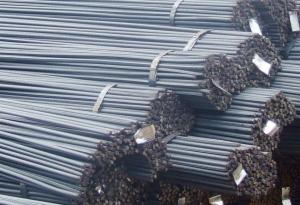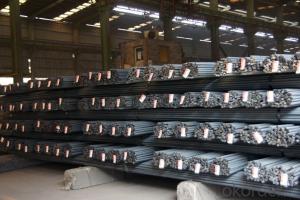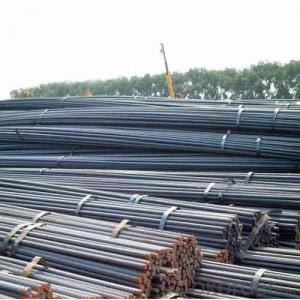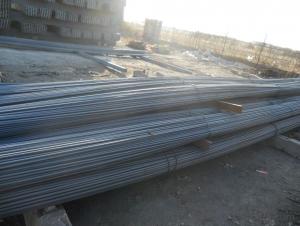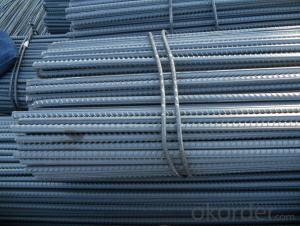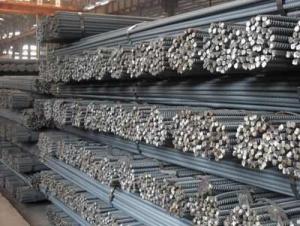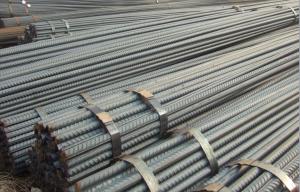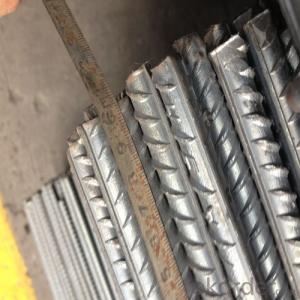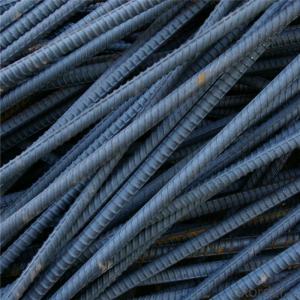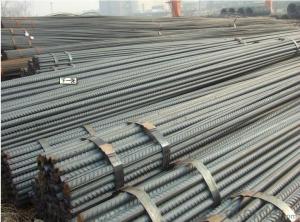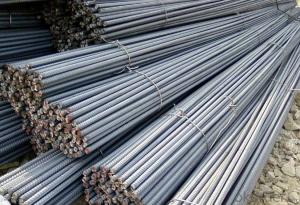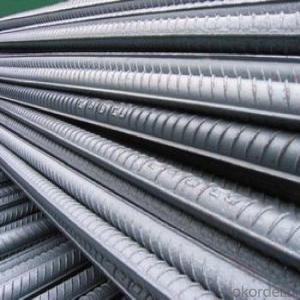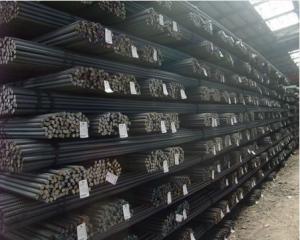Deformed Steel Bar ASTM A615 GR40 GR60 Or BS 4449
- Loading Port:
- China Main Port
- Payment Terms:
- TT or LC
- Min Order Qty:
- -
- Supply Capability:
- -
OKorder Service Pledge
OKorder Financial Service
You Might Also Like
Product Description:
OKorder is offering high quality Hot Rolled Steel I-Beams at great prices with worldwide shipping. Our supplier is a world-class manufacturer of steel, with our products utilized the world over. OKorder annually supplies products to European, North American and Asian markets. We provide quotations within 24 hours of receiving an inquiry and guarantee competitive prices.
Product Applications:
Deformed bar is widely used in buildings, bridges, roads and other engineering construction. Big to highways, railways, bridges, culverts, tunnels, public facilities such as flood control, dam, small to housing construction, beam, column, wall and the foundation of the plate, deformed bar is an integral structure material. With the development of world economy and the vigorous development of infrastructure construction, real estate, the demand for deformed bar will be larger and larger
Product Advantages:
OKorder's Steel I-Beams are durable, strong, and resist corrosion, exact size, regular package, chemical and mechanical properties are stable.
Main Product Features:
· Premium quality
· Prompt delivery & seaworthy packing (30 days after receiving deposit)
· Corrosion resistance
· Can be recycled and reused
· Mill test certification
· Professional Service
· Competitive pricing
Product Specifications:
Manufacture: Hot rolled
Grade: BS4449
Certificates: ISO, SGS, BV, CIQ
Diameter: 6mm,8mm,10mm,12mm,14mm,16mm,18mm,20mm,
22mm,25mm,28mm,32mm,36mm,40mm,50mm
Length: 6M, 9M,12M or as required
Packaging: Export packing, nude packing, bundled
Chemical Composition: (Please kindly find our chemistry of our material based on HRB500 as below for your information)
Grade | Technical data of the original chemical composition (%) | ||||||
C | Mn | Si | S | P | V | ||
HRB400 | ≤0.25 | ≤1.60 | ≤0.80 | ≤0.045 | ≤0.045 | 0.04-0.12 | |
Physical capability | |||||||
Yield Strength (N/cm²) | Tensile Strength (N/cm²) | Elongation (%) | |||||
≥400 | ≥570 | ≥14 | |||||
Theoretical weight and section area of each diameter as below for your information:
Diameter(mm) | Section area (mm²) | Mass(kg/m) | Weight of 12m bar(kg) |
6 | 28.27 | 0.222 | 2.664 |
8 | 50.27 | 0.395 | 4.74 |
10 | 78.54 | 0.617 | 7.404 |
12 | 113.1 | 0.888 | 10.656 |
14 | 153.9 | 1.21 | 14.52 |
16 | 201.1 | 1.58 | 18.96 |
18 | 254.5 | 2.00 | 24 |
20 | 314.2 | 2.47 | 29.64 |
22 | 380.1 | 2.98 | 35.76 |
25 | 490.9 | 3.85 | 46.2 |
28 | 615.8 | 4.83 | 57.96 |
32 | 804.2 | 6.31 | 75.72 |
36 | 1018 | 7.99 | 98.88 |
40 | 1257 | 9.87 | 118.44 |
50 | 1964 | 15.42 | 185.04 |
FAQ:
Q1: How soon can we receive the product after purchase?
A1: Within three days of placing an order, we will begin production. The specific shipping date is dependent upon international and government factors, but is typically 7 to 10 workdays.
Q2: What makes stainless steel stainless?
A2: Stainless steel must contain at least 10.5 % chromium. It is this element that reacts with the oxygen in the air to form a complex chrome-oxide surface layer that is invisible but strong enough to prevent further oxygen from "staining" (rusting) the surface. Higher levels of chromium and the addition of other alloying elements such as nickel and molybdenum enhance this surface layer and improve the corrosion resistance of the stainless material.
Q3: Can stainless steel rust?
A3: Stainless does not "rust" as you think of regular steel rusting with a red oxide on the surface that flakes off. If you see red rust it is probably due to some iron particles that have contaminated the surface of the stainless steel and it is these iron particles that are rusting. Look at the source of the rusting and see if you can remove it from the surface.

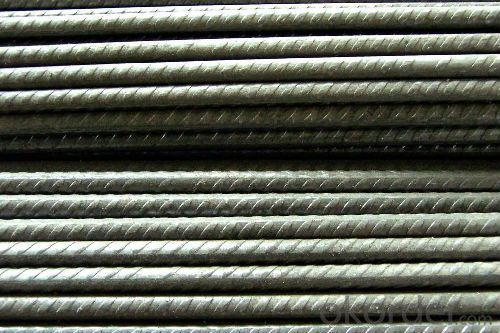
- Q: What are the safety precautions to be taken while handling steel rebars?
- When handling steel rebars, it is important to follow several safety precautions. First and foremost, proper personal protective equipment (PPE) should be worn, including gloves, safety glasses, and steel-toed boots. This will help protect against potential injuries and hazards. Additionally, it is crucial to lift and carry rebars using proper lifting techniques and equipment, such as using cranes or forklifts, as rebars can be heavy and awkward to handle. Workers should also be cautious of sharp edges or protruding ends of rebars and ensure they are properly capped or covered. Lastly, it is essential to maintain a clean and organized work area, removing any obstacles or tripping hazards to prevent accidents.
- Q: What is the role of steel rebars in the construction of highway overpasses?
- Steel rebars play a crucial role in the construction of highway overpasses as they provide reinforcement and strength to the concrete structures. Rebars are used to reinforce the concrete, preventing cracks and improving its resistance to tension and bending forces. This reinforcement ensures the durability, stability, and overall safety of the highway overpasses, allowing them to withstand heavy loads and harsh external conditions.
- Q: Can steel rebars be used in underwater construction?
- Yes, steel rebars can be used in underwater construction. They are commonly used to reinforce concrete structures in underwater environments such as bridges, piers, and offshore platforms. The steel rebars are designed to be corrosion-resistant, ensuring their durability and strength even when submerged in water for extended periods.
- Q: How are steel rebars marked for identification on construction sites?
- Various methods are commonly used to mark steel rebars for identification on construction sites. The primary method involves attaching tags or labels to the rebars, which contain crucial information like the rebar's diameter, grade, length, and any necessary specifications or codes. In addition to tags, rebars can also be marked with paint or ink. This can be achieved by either spraying or stenciling the required information directly onto the rebar's surface. Paint or ink markings are typically used for temporary identification or when using tags is not feasible. Another marking method involves using colored plastic or vinyl caps on the ends of the rebars. These caps are usually color-coded to indicate different characteristics, such as rebar size or type. This allows for easy visual identification on the construction site. It's important to note that the specific method of marking rebars may vary based on local regulations, project requirements, or the preferences of the construction company or engineer. The purpose of these markings is to ensure that rebars can be easily identified and sorted during construction, promoting proper installation and adherence to design specifications.
- Q: How to judge the quality of thread steel?
- Use material tester to measure data, then compare with national standard data.
- Q: How do steel rebars enhance the load-bearing capacity of a structure?
- Steel rebars serve to enhance the load-bearing capacity of a structure by reinforcing and strengthening the concrete. Essentially, they are embedded within the concrete, acting as a skeleton or framework that provides additional strength to the structure. The main purpose of steel rebars is to withstand tension forces that the concrete alone may not be able to withstand. When a structure is subjected to heavy loads or external forces, such as earthquakes or wind, the concrete may crack or fail under the stress. However, the steel rebars help distribute and absorb these forces, preventing the concrete from breaking apart. The ribbed surface of the rebars improves the bond between the steel and the concrete, ensuring effective transfer of loads between the two materials. This bond allows the rebars to resist tension and compression forces, as well as shear forces, resulting in an overall increase in load-bearing capacity. Moreover, steel rebars help control and limit the width and depth of cracks that may occur in the concrete. By restraining crack propagation, rebars prevent the cracks from expanding and compromising the structural integrity of the building. This is particularly crucial in earthquake-prone regions, where a structure's ability to withstand ground movements is of utmost importance. Additionally, steel rebars contribute to the durability and longevity of a structure. They possess high tensile strength, enabling them to withstand significant pulling forces without deforming or breaking. This property ensures that the structure remains stable and secure over time, even under dynamic or extreme loading conditions. In conclusion, steel rebars play a vital role in enhancing the load-bearing capacity of a structure by reinforcing the concrete, increasing its resistance to tension forces, and controlling crack propagation. Their presence significantly improves the structural integrity, durability, and safety of buildings, making them an indispensable component in modern construction practices.
- Q: Can steel rebars be used in structures with curved or irregular shapes?
- Yes, steel rebars can be used in structures with curved or irregular shapes. The flexibility and malleability of steel allow rebars to be bent and shaped according to the desired design, making it suitable for various architectural and engineering applications.
- Q: Can steel rebars be used in nuclear power plants?
- Yes, steel rebars can be used in nuclear power plants. Steel rebars are commonly used in construction projects, including nuclear power plants, to reinforce concrete structures. These rebars provide added strength and stability to the concrete, enhancing its ability to withstand various loads and forces. However, it is important to note that the use of steel rebars in nuclear power plants must comply with specific regulations and standards to ensure the safety and integrity of the plant. These regulations may include requirements for the type of steel used, its composition, and mechanical properties. Additionally, the rebars must undergo rigorous quality control measures to ensure they meet the required standards and are free from any defects that could compromise the structural integrity of the plant. Overall, steel rebars can be safely used in nuclear power plants as long as they meet the necessary regulatory requirements and quality control measures.
- Q: Can steel rebars be used in structures exposed to extreme temperatures?
- Yes, steel rebars can be used in structures exposed to extreme temperatures. Steel has high thermal conductivity, which allows it to transfer heat quickly, minimizing the risk of structural damage due to thermal expansion or contraction. However, it is essential to consider the specific temperature range and the potential impact on the structural integrity of the rebar. In extremely high temperatures, other materials or protective measures may be necessary to ensure the stability and safety of the structure.
- Q: What are the different types of steel rebars used in road construction?
- There are typically two types of steel rebars used in road construction: plain steel bars and deformed steel bars. Plain steel bars are smooth and have no ridges or deformations. Deformed steel bars, on the other hand, have ridges, protrusions, or other patterns on their surface to improve the bond strength between the rebar and the surrounding concrete. Both types of rebars are commonly used in road construction to reinforce and strengthen the concrete structures.
Send your message to us
Deformed Steel Bar ASTM A615 GR40 GR60 Or BS 4449
- Loading Port:
- China Main Port
- Payment Terms:
- TT or LC
- Min Order Qty:
- -
- Supply Capability:
- -
OKorder Service Pledge
OKorder Financial Service
Similar products
Hot products
Hot Searches
Related keywords
